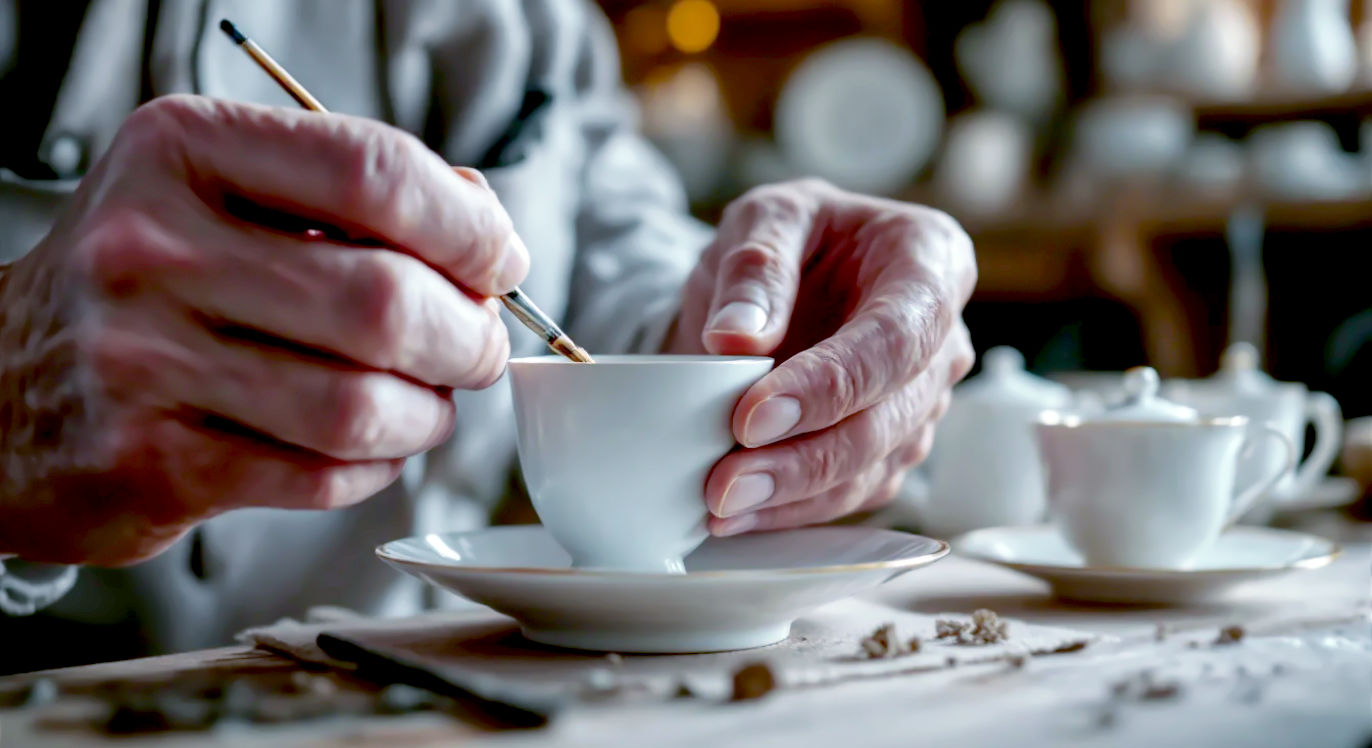The Great British Story of Porcelain: How Stoke-on-Trent’s Potteries Shaped the Nation’s Tables
The definitive guide to British porcelain. Explore the history of The Potteries in Stoke-on-Trent, the invention of bone china, and the iconic makers.

This post may contain affiliate links. If you make a purchase through these links, we may earn a commission at no additional cost to you.
Pull up a chair. Let’s talk about the teacup you’re holding, or the dinner plate you save for Christmas. Chances are, it’s a delicate, almost see-through piece of porcelain. It feels special, doesn’t it? It’s not just a bit of crockery; it’s a piece of British history, a story of art, science, and a whole lot of mud. And that story was fired into life in a small corner of Staffordshire known as The Potteries.
For centuries, this cluster of six towns—Stoke, Hanley, Burslem, Tunstall, Longton, and Fenton—was the beating heart of the world’s ceramic industry. It was a landscape of smoking bottle kilns, a place where generations of families turned local clay into treasures that graced tables from Buckingham Palace to Boston. This isn’t just a story about plates and cups. It’s the story of how a British industry conquered the world, defined elegance for millions, and left a legacy that’s as tough and beautiful as the bone china it created.
We’ll journey back to a time when porcelain was a mystery from the East, follow the innovators and artists who cracked its code, and discover how their creations became woven into the very fabric of British life. So, let’s get to the bottom of what makes your nan’s best china so special.
The Great Porcelain Race: A British Obsession Begins
Long before we Brits mastered it, porcelain was the stuff of legend. A mysterious, beautiful material from the Far East that baffled the cleverest minds in Europe.
From Far East Mystery to European Quest
For over a thousand years, China held the secret to porcelain. They made it from a special white clay called kaolin, mixed with a type of rock called petuntse, and fired it at mind-bogglingly high temperatures. The result was something Europe had never seen: it was tough, brilliantly white, and so fine you could almost see light through it.
When traders like Marco Polo brought this ‘white gold’ back, it caused a sensation. Kings and queens would pay a fortune for a single vase. It was more valuable than silver. Naturally, everyone in Europe wanted to figure out how to make it. The Germans were the first to crack the code in the early 1700s, creating Meissen porcelain. This only made the British more determined to create their own.
Britain Joins the Fray
The first British attempts in the mid-18th century, at places like Chelsea and Bow in London, were a good effort. They created something called ‘soft-paste’ porcelain. It was lovely, but it was fragile and had a nasty habit of cracking if you poured boiling water into it—not ideal for a nation just discovering its love for tea.
The challenge was finding the right recipe. Potters across the country were desperately experimenting, trying to create a porcelain that was as white as the Chinese original but strong enough to survive a British teatime. The race was on, and the winner would be found not in the grand workshops of London, but in the smoky, clay-rich lands of Staffordshire.
Stoke-on-Trent: How Six Towns Became the World’s Kiln
So, why Stoke? What was so special about this part of the Midlands? It turns out, it was a bit of a perfect storm. The area had everything a potter could dream of, right under its feet.
A Perfect Recipe for Pottery
Firstly, there was clay. The local earth was rich in different types of clay, perfect for making earthenware. Secondly, it had coal in abundance, essential for firing the kilns to the blistering temperatures needed for pottery.
But the real genius was in how they connected it all. Visionary industrialists like Josiah Wedgwood championed the building of canals. The Trent and Mersey Canal, finished in 1777, was a game-changer. It meant raw materials like fine white kaolin clay could be shipped in cheaply from Cornwall, and the fragile finished pots could be transported safely to ports like Liverpool, ready to be sent across the globe.
This combination of local resources and brilliant infrastructure turned Stoke-on-Trent into a pottery powerhouse. The six towns, officially federated as the city of Stoke-on-Trent in 1910, became known simply as The Potteries—the undisputed world capital of ceramics.
The Game Changer: The Invention of Bone China
For all its success with earthenware, The Potteries’ biggest gift to the world was yet to come. It was an invention that would define British porcelain forever: bone china. It sounds a bit grim, but this discovery created a material that was elegant, brilliant white, and incredibly strong.
What is Bone China?
Think of making a cake. You have your flour, sugar, and eggs. But what if you added a secret ingredient that made the cake stronger, whiter, and finer than any other? That’s basically what bone china is.
The standard porcelain recipe used china clay (kaolin) and china stone (petuntse). The British breakthrough was to add a third, crucial ingredient: calcined animal bone, or bone ash.
The Spode Secret
The man credited with perfecting this recipe was Josiah Spode (the second of that name). Around 1799, at his factory in Stoke, he figured out the perfect formula: roughly 50% bone ash, 25% Cornish stone, and 25% kaolin clay.
This was revolutionary. The bone ash did something magical in the kiln. It made the porcelain easier to fire, reduced breakages, and produced a body that was whiter and more translucent than anything seen before. But here’s the clever bit: it was also ridiculously strong. You could make it incredibly thin, giving it a wonderful delicacy, but it wouldn’t chip or crack easily.
It was the perfect material for a country that loved a good brew. It could handle boiling water, withstand daily use, and still look utterly refined. Bone china wasn’t just a technical achievement; it was the answer to a nation’s prayers.
Fine China vs. Bone China: What’s the Difference?
It’s a common point of confusion, but the answer is simple.
- Bone China contains at least 30% bone ash in its recipe. This gives it its signature strength, translucency, and bright white colour. It’s the quintessential British porcelain.
- Fine China is a term for other high-quality porcelains that don’t use bone ash. They are still beautiful but tend to be slightly less durable and have a softer, creamier white colour.
So, if you hold a plate up to the light and can see the shadow of your fingers through it, you’re likely holding a piece of bone china.
Giants of the Potteries: The Names on the Bottom of Your Nan’s Best China
The Potteries was home to hundreds of factories, but a few legendary names rose above the rest. These were the innovators, artists, and marketing geniuses who turned Stoke-on-Trent into a byword for quality.
Wedgwood: The Master of Innovation (Founded 1759)
You can’t talk about British pottery without talking about Josiah Wedgwood. He was the ultimate combination of scientist, artist, and businessman. He believed in constant experimentation and was obsessed with quality.
- The Man: Wedgwood wasn’t just a potter; he was a social reformer, an abolitionist, and a marketing pioneer. He understood that to sell his pots, he needed to create a desire for them. He courted royalty, opening one of the first London showrooms to show off his wares.
- Signature Wares: While he made all sorts of pottery, he’s most famous for Jasperware. You know it the second you see it: that iconic, unglazed stoneware in “Wedgwood blue” (or sage green, or black) decorated with delicate white classical scenes. He also perfected a beautiful, cream-coloured earthenware he called Queen’s Ware, after Queen Charlotte fell in love with it. It was elegant but affordable, bringing a touch of royal style to middle-class tables.
Spode: The Father of Bone China (Founded c. 1770)
We’ve already met Josiah Spode the second, the man who perfected bone china. But the factory he inherited from his father was also a master of decoration.
- The Blue Italian Pattern: Spode’s most enduring legacy is the Blue Italian pattern, launched in 1816. You’ve definitely seen it. It’s a beautifully detailed scene of an Italian ruin, framed by a traditional Japanese-inspired border, all printed in a rich cobalt blue. It has been in continuous production for over 200 years, making it one of the most recognisable tableware designs in history. It perfectly captures that British love for the exotic and the classical, all on one plate.
Royal Doulton: From Pipes to Pretty Figurines (Founded 1815)
Not every pottery giant started out making fine china. Doulton began its life in Lambeth, London, making something far less glamorous: salt-glazed sewer pipes. But their industrial ceramics were so good that they earned a reputation for quality.
By the late 19th century, they had moved into decorative wares and, after acquiring a factory in Burslem, into the world of fine bone china. They are most famous for their collectible figurines—elegant ladies, historical figures, and adorable animals—and their quintessentially British Character Jugs. For many, Royal Doulton is the face of collectible British pottery.
Minton, Aynsley, and Others: The Supporting Cast
The big three weren’t alone. The Potteries was a thriving ecosystem of incredible talent.
- Minton was known as the finest china maker in the world, supplying embassies and royalty with lavish, richly gilded dinner services.
- Aynsley specialised in beautiful, floral teaware that became a staple of wedding gift lists for generations.
- Brands like Royal Worcester (just outside Staffordshire but a key player), Coalport, and Royal Crown Derby all contributed to Britain’s reputation for ceramic excellence.
From Clay to Cup: How a Piece of Porcelain is Born
Creating a piece of bone china is a magical process, a blend of raw nature and human skill that hasn’t changed all that much in 200 years. It’s a journey through fire and water, guided by the hands of master craftspeople.
The Magic Mix
It all starts with the raw materials, the ‘body’ of the china. Huge machines grind the Cornish stone, kaolin clay, and bone ash with water into a smooth, creamy liquid called slip. This slip is the lifeblood of the factory.
Shaping the Future
This liquid clay can now be shaped. For hollow items like teapots or the handles of cups, the slip is poured into plaster moulds. The plaster absorbs the water, leaving a thin layer of clay on the inside. The excess is poured out, and voilà, you have a hollow teapot. For flat items like plates and saucers, a lump of clay pug is spun on a wheel and pressed into shape by a tool—a process charmingly known as ‘jollying’.
Trial by Fire: The Two-Kiln Process
The shaped clay is still fragile. To turn it into hard porcelain, it needs to face the fire.
- The Biscuit Firing: The pieces are packed into the kiln for their first firing, at around 1250°C. This is the ‘biscuit’ firing. It burns away any impurities and turns the soft clay into a hard, but still porous, white body.
- The Glost Firing: Next, the biscuit-fired piece is dipped into a vat of liquid glaze. This coats it in a thin, glassy layer. It then goes back into a second kiln for the ‘glost’ (glazed) firing, at a slightly lower temperature. This melts the glaze, creating that smooth, shiny, and non-porous surface that makes porcelain so practical.
A Touch of Artistry: The Decorating Studio
The plain white piece, known as ‘whiteware’, is now a blank canvas. The decorators are the artists who bring it to life.
- Lithography: Most patterns today are applied using ceramic transfers, or lithographs. These are printed with special ceramic pigments. The backing paper is soaked off, leaving the pattern on the plate. It’s a highly skilled job to apply these without any creases or bubbles.
- Hand-Painting and Gilding: For the most luxurious pieces, details are still painted by hand. The most skilled artisans apply lines of liquid gold or platinum with a fine brush. These pieces then need a final, third trip to the kiln to fuse the precious metals permanently onto the glaze.
More Than Just Plates: Porcelain and British Culture
The creations of Stoke-on-Trent did more than just hold our food and drink. They reflected our aspirations, shaped our rituals, and became a quiet but constant backdrop to British family life.
The Afternoon Tea Revolution
You can’t really have a proper afternoon tea without proper china. The rise of this beloved British ritual in the 19th century went hand-in-hand with the production of beautiful, affordable bone china tea sets. The delicate cups, the matching saucers, the little milk jug and sugar bowl—they were all part of the theatre of teatime. Fine china made a simple cup of tea feel like an occasion.
A Mark of Class
For the growing Victorian middle classes, owning a ‘best dinner service’ was a powerful status symbol. It was something to be proud of, kept in a display cabinet and brought out for special occasions like Christmas or an important Sunday lunch. It showed you had taste, you appreciated quality, and you had ‘arrived’. The potteries of Stoke-on-Trent were, in effect, selling social mobility, one plate at a time.
A Collector’s Guide: Tips for Enthusiasts
Whether you’re browsing a car boot sale or inheriting a family heirloom, it’s fun to know a bit more about what you’re looking at.
Reading the Signs: The Backstamp
The most important clue is on the bottom. The backstamp is the maker’s mark, and it can tell you who made the piece, and often, roughly when.
- Look for famous names like Wedgwood, Spode, or Royal Doulton.
- The inclusion of the word “England” usually means it was made after 1891.
- “Made in England” suggests a 20th-century piece.
- Many marks included symbols or codes that can help date a piece more precisely. A quick search online for the maker’s name and “backstamps” can open up a world of information.
Caring for Your Treasures
Bone china is tough, but it’s not indestructible. To keep it looking its best:
- Don’t use the dishwasher. The harsh detergents and high temperatures can fade the patterns and damage the gold gilding.
- Wash by hand in warm, soapy water. Use a soft cloth, not a scourer.
- Avoid sudden temperature changes. Don’t pour boiling water into a cold teapot; warm the pot first.
- When stacking plates, place a paper napkin between each one to prevent scratches.
The Potteries Today: Fire, Smoke, and Rebirth
The 20th century was tough on The Potteries. The decline of the British Empire, changing tastes, and, most importantly, competition from cheap mass-produced ceramics from abroad led to the closure of many historic factories. The skyline of bottle kilns, once numbering over 2,000, slowly disappeared.
A Modern Renaissance
But the story isn’t over. In recent years, there has been a passionate revival. Brands like Wedgwood and Spode (now part of the same group) continue to produce classic designs while innovating with new ones. Heritage is now a huge draw, with factory tours and magnificent museums like The Potteries Museum & Art Gallery and the Gladstone Pottery Museum celebrating the area’s unique history.
A new generation of studio potters and ceramic artists are setting up workshops in Stoke, drawn by the heritage and the community of skill that still exists there. They are reimagining what British ceramics can be in the 21st century.
Conclusion: The Unbreakable Spirit of Stoke-on-Trent
The story of British porcelain is a story of alchemy—of turning mud, stone, and bone into objects of delicate beauty. For over 250 years, the potters of Stoke-on-Trent mastered this magic. They didn’t just create dinnerware; they created heirlooms, status symbols, and the essential props for our nation’s favourite daily ritual.
Every time you pick up a piece of fine bone china, you are holding that legacy in your hands. It’s the story of artistry and industry, of local pride and global reach. It’s the unbreakable spirit of The Potteries, fired into every single piece.
Further Reading
- The Victoria and Albert Museum (V&A): Explore one of the world’s greatest collections of ceramics. https://www.vam.ac.uk/collections/ceramics
- The Potteries Museum & Art Gallery: Home to the world’s finest collection of Staffordshire ceramics. https://www.stokemuseums.org.uk/pmag
- World of Wedgwood: Discover the story of Josiah Wedgwood and see craftsmanship in action. https://www.worldofwedgwood.com






